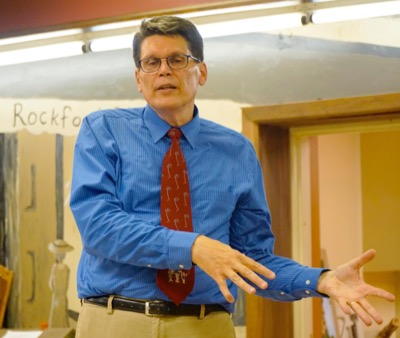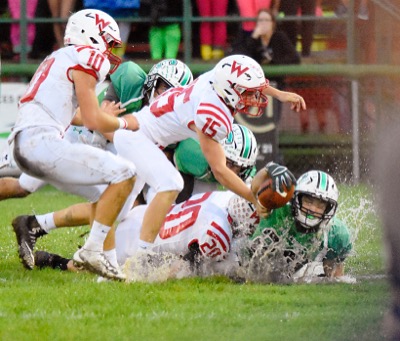Saturday, October 6th, 2018
Book tells shocking story of lynching
By William Kincaid

Photo by William Kincaid/The Daily Standard
Dr. David Kimmel holds an audience spellbound while discussing his new book, "Outrage in Ohio: A Rural Murder, Lynching and Mystery." Kimmel will speak to the Mercer County Genealogical Society at 2 p.m. Sunday in Celina's Richardson-Bretz Building, 119 W. Fulton St. The event is open to the public.
ROCKFORD - "Two bodies slowly turn on the ends of ropes. A soiled ribbon rests on a table. A young man sits in a cell, measuring out the days, weeks and months," professor David Kimmel told a rapt audience recently at Rockford's village hall/museum.
Somewhere in this heap of broken images lies the truth about what transpired in the aftermath of the rape and murder of a 13-year-old girl nearly 150 years ago in Liberty Township in northwest Mercer County, Kimmel said.
Reading passages from his newly published book, "Outrage in Ohio: A Rural Murder, Lynching and Mystery," and sharing details from his exhaustive, yearslong research, Kimmel laid bare the story of Mary Secaur's demise and the vengeance inflicted upon her suspected assailants by an enraged mob that took the law into its own hands.
On June 23, 1872, a Sunday morning, Secaur left the home of her foster parents, John and Sarah Sitterly on what is now Tama Road to the Liberty United Brethren Church for Sunday school and church services, according to Kimmel.
Afterward, sometime past noon, Secaur walked west with a group of parishioners. The group thinned out as Secaur continued to walk past her grandfather's home, Kimmel said.
Secaur never showed up at home, though, and the next day, her foster father, after inquiring about Secaur's whereabouts, put together a search team.
"So they gathered together a large team of neighbors, and they started at the chapel and worked their way back down the street, stopping at each house, asking who had seen her," Kimmel said.
After four hours, Secaur's body was found within two feet of a thicket just off the road near the Sitterly house, Kimmel continued. He noted the body was horribly mangled, the head was separated from the body and the skull crushed, with parts of it gone. The body had lain in the spot for more than 27 hours in the midst of a heat wave, he said.
Free-ranging hogs had fed upon the body, he said. Nearby, was a bloodied club.
"After some investigation and several aborted arrests - they arrested several people and young men in the area and then let them go - suspicion settled on two traveling tin peddlers from Fort Wayne, Alexander McLeod and Andrew Kimmel, who had stayed over the weekend with Andrew's uncle, Henry Kimmel, my great-great-great grandfather," Kimmel said.
Sheriff Thornton Spriggs and a small group of deputies raced off in pursuit of the two tin peddlers and caught up with them in the center of Fort Wayne's business district, Kimmel said. The group literally jumped out with pistols and ordered the two men into the wagon.
"Now remember, this was across state lines," Kimmel told the audience. "They had no warrant. They had no permission from the governor. This is highly illegal, but they did arrest them."
On the way back to Celina, the group stopped at Henry Kimmel's, where they arrested three brothers, Absalom, 19; Jacob, 18; and George, 16. They were then transported to the jail in Celina, he said.
What ensued were conflicting, and in one case, recanted testimonies and confessions, according to Kimmel. Eventually, Absalom Kimmel signed a long, detailed confession implicating McLeod, Jacob Kimmel and himself in the rape and McLeod in the murder.
"There's several reasons why I doubt the authenticity of this confession," Kimmel said. "One reason is it's more sophisticated language than Absalom uses in any other examples and there's descriptions of him being very much below the average of intelligence."
On a Monday morning, a large crowd, estimated at as large as 3,000 people, gathered in Celina, giving birth to a lynching party, Kimmel said.
"This group, along with a wagon to transport the prisoners, rode over to the jail where they broke in, overpowered the sheriff and his deputies, took the sheriff's keys and removed the three suspects (Absalom and Jacob Kimmel and McLeod) from their cells," he said. "The prisoners were shackled, loaded onto the wagon and driven to the murder site."
At the murder site, the property owner persuaded the group to commit the lynching elsewhere. The crowd moved the proceedings to Henry Kimmel's property and fashioned a rough gallows from tree limbs. The wagon rolled underneath the ropes and the suspects were ordered to confess to the crimes.
However, Jacob Kimmel was spared the fate of the other two suspects when Elias Secaur, brother of the murdered Mary Secaur, convinced the crowd to let him go.
When the circuit court convened, Jacob Kimmel was released from jail. It declined to prosecute anyone involved in the lynching of Absalom Kimmel and McLeod.
"Did these boys do this or not? I don't know. There's no way to really, 100 percent tell in the end. I kind of think it's easy to make the case that the authorities were looking for somebody," he said, adding that they chose to pin the wrap on an outside tin peddler and a possibly mentally challenged man.




